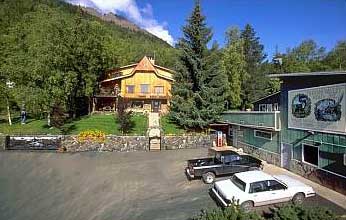 by Doug Schneider June 08, 2004 Alaska's wild salmon runs are some of the largest in the world. For years, Alaska fishermen had no problem selling their bumper catches to a hungry world market willing to pay a premium price. But lately, Alaska salmon has become a tough sell. Quite simply the world is awash in salmon-both the kind that grow naturally in the ocean and the kind raised on
Just south of Anchorage, Alaska, along the highway to Portage Glacier and the fishing communities of the Kenai Peninsula, is Indian Valley Meat Company, a custom meat and seafood business run by longtime Alaskan Doug Drum. As a former commercial fisherman, he remembers the good old days when about the only thing a fisherman had to do to make a lot of money was simply bring salmon to the dock. Doug Drum said, "Used to be that you could take the fish, head and gut it and sell it to Japan and make a little money. That day is about gone. The money is in value-added processing." By value-added, Drum means turning a freshly caught salmon into products that command a much higher price than the fish itself. At his processing plant, Drum's employees make salmon burgers, salmon jerky, boneless and skinless fillets, lox, kippers, and three varieties of smoked salmon. His customers are everyone from tourists to large natural food stores like Wild Oats Markets and Whole Foods Markets, which each operate more than 100 stores in the United States and Canada. Drum said, "This one company we deal with did $1.2 million last year, much of it was fish we processed for them. This year they will break $5 million and they figure next year they will double that." The U.S. market for value-added salmon products is so big that even Indian Valley Meat Company, with more than $2.2 million in annual sales, can't take care of it all. That's why for the past several years, Drum has been doing something most sane businessmen would never do: he's training the competition. Drum has established a seafood quality and "Fishermen can't afford-because of the cost of fuel, the cost of nets and all the other equipment needed to fish-they can't afford to sell these fish for thirty-five or forty cents a pound. They just don't make any money. These fishermen aren't dumb. They go down to the store and see their red salmon selling for 10, 11, or 12 dollars a pound. What's going on here? The reason is because the money is in the value added. It's always been there, but nobody wanted to tell the fishermen that," said Drum. Drum teaches students-many of them fishermen and entrepreneurs from Alaska's rural villages-the basic skills needed to operate a seafood processing plant. Seafood quality experts from the University of Alaska Fairbanks Marine Advisory Program come in to provide specialized instruction on issues such as seafood quality control, sanitation standards, and federally mandated food safety protocols. Don Kramer is a seafood quality specialist with the Marine Advisory Program. He says even as large seafood companies close down antiquated, unprofitable processing plants around the state, a rebirth of the salmon industry is happening behind the scenes. Don Kramer said, "They're looking at a wider variety of products that are more processed than just headed and gutted. So producing high-quality fish and a wider variety of products is going to continue." Doug Drum says he's not really worried about the competition he's helping to create. Drum said, "I have had
a lot of criticism from people who say I spent a lifetime learning
this and that I'm crazy for giving it away for nothing. But the
way I look at it is that I have been here for 37 years and I
look at the state as a whole. There is such a huge market out
there that we could all work together to sell a quality salmon
product out of the state of Alaska."
Story Courtesy Arctic Science
Journeys. Produced by the Alaska Sea Grant College Program and
the University of Alaska Fairbanks. The shortcut to our ASJ news
home page is www.asjnews.org.
|
|||
